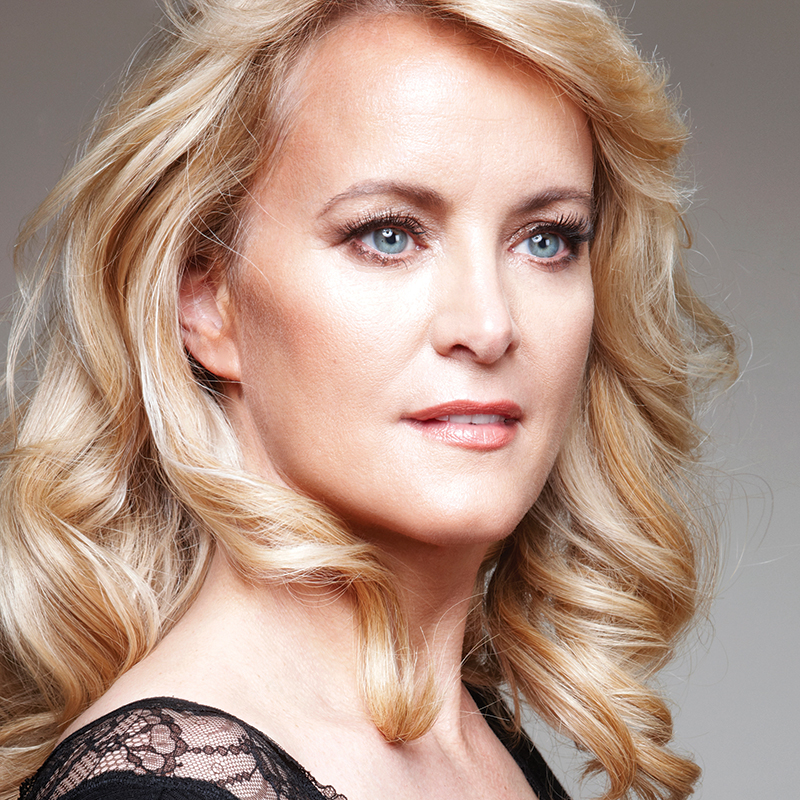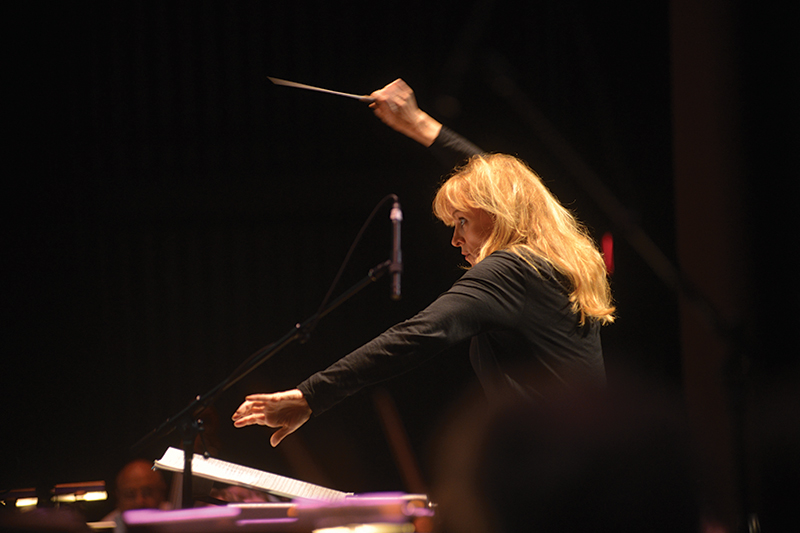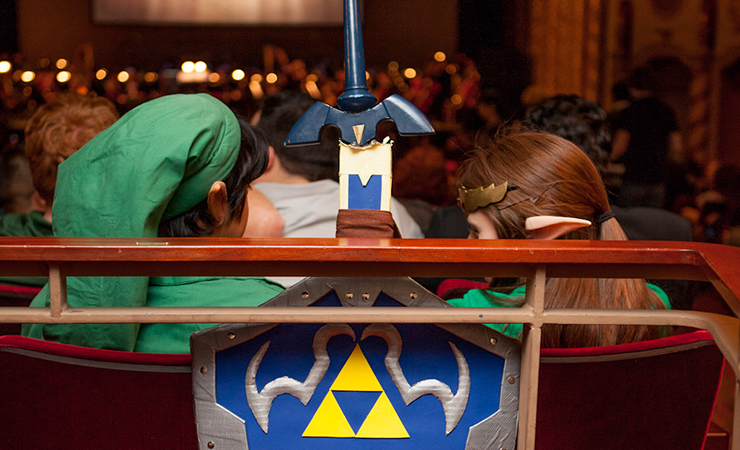Hey, Listen! Amy Andersson Conducts The Legend of Zelda: Symphony of the Goddesses
Music Interviews
You know, there was a time—not too long ago—when video games weren’t cool. Sure, just about anyone could pick out Mario in a lineup and play split-screen Goldeneye 007 with their buddies, but most people would have thought it pretty lame to hear somebody go on about how much they really connected with the music that made games like these such a lasting part of our lives. Franchises like The Legend of Zelda, Final Fantasy and Mega Man boasted incredible scores that still resound with echoes of childhood discovery, a constant source of nostalgia those of us who spent their formative years exploring virtual, fantastical worlds. Nowadays, long-time fans and devoted neophytes can rediscover this music through live symphonic renditions, recontextualizing and legitimizing these scores that still inspire awe and wonder.
The Legend of Zelda: Symphony of the Goddesses performed on The Late Show with Stephen Colbert last night, and after hearing their rousing medley of classic The Legend of Zelda songs, it’s hard not to get excited for the show coming up tomorrow night at Abravanel Hall. Amy Andersson, who acts as conductor of this incredible ensemble, was gracious enough to grant SLUG an interview in advance of the show. We asked her some questions about the series and her experience as a classically trained conductor, and she responded with a combination of warmth and musical knowledge.
 SLUG: Tell me about your previous experiences as a conductor and as a musician.
SLUG: Tell me about your previous experiences as a conductor and as a musician.
Amy Andersson: Well, I come from a classical music background. I got my undergraduate and Master’s degree in conducting, so I have been largely in the classical field doing symphonic music and operatic music. I worked in Germany for 10 years—in the opera houses there—so I got extensive experience in the art of conducting and the art of rehearsing.
SLUG: What made you gravitate toward conducting?
Andersson: I was trained as a pianist. I went to the music program at the University of Michigan, and they had wonderful orchestras. I always found myself hanging around the orchestras, and playing auxiliary instruments—you know, percussion instruments or celeste or keyboard—when they needed. I was totally enthralled and taken by and intoxicated with the orchestral repertoire—you know, the sound of the orchestra, the color of the orchestra … the totality of how remarkable a symphony orchestra is. I thought, “How can I be part of this miraculous sort of thing?” and “How can I partake in some of the repertoire?” I went to rehearsals all the time and I watched conductors—then it sort of dawned on me. You know, I wasn’t going to start playing the violin at that point, but it dawned on me that I could be a conductor and participate. So I started taking conducting courses and learning the art of conducting, and hence began a lifelong interest and passion in conducting. You know, what do you do to conduct an orchestra? How can you speak through your hands without words?
SLUG: Most people see the conductor at the head of the stage and they don’t realize the kind of training that goes into conducting. In a rock n’ roll band, you’re only dealing with about four or five other people, but when you have 40 or 80 musicians in front of you, that’s a different story entirely.
Andersson: Yeah, and when I was in Germany, I was doing whole opera productions where I had all the singers onstage and the orchestra in the pit. It dawned on me then that this was what I really wanted to do and what I needed to do. It fulfilled my musical need and hunger on every level.
SLUG: When you talk about the “color” of the orchestra, what do you mean by that? How does one come to think of music in terms of color?
Andersson: Composers have always talked about color, and as musicians, we train our ears to hear color. For the layman’s term, you can use the term “color” to describe tone. For example, if the tone is dark—you can darken the color.
It all comes back to the voice—the first human instrument. You can have a very bright-sounding voice in the way you sing by the way you place it, or you can have a more hollow singing voice by the placement, or it can be very far back in the throat and be very covered, very dark. There’s a lot of different colors you can make through vocal technique. You can also do that when you play an instrument, and composers combine certain instruments to play at once for a certain color. They’ll use brass for a bright, piercing, flashy sound, and then they’ll use some of the woodwinds—the bass clarinet and the contrabassoon—to make a darker sound. In the vocabulary of musicians and composition and music, there’s a notion that sound can have a color to it.
There’s the color of French music—of [Claude] Debussy and [Maurice] Ravel—that’s orchestrated so that it is very transparent and there’s a light, beautiful, shimmering color, as you will, to the compositions. Then there are composers like Johannes Brahms, who wrote the Brahms symphonies—among other pieces—who bring out the rich, dark, deep sound of the orchestra—particularly the strings.
SLUG: So, getting to The Legend of Zelda: Symphony of the Goddesses, what are some of the colors you detect in the scores?
 Andersson: There are many different colors and characteristics because the orchestration and themes by Koji Kondo draw from a wide palette of musical genres. It’s very eclectic. They sort of borrow from everything. It can go anywhere from pointillistic-sounding—with strings and winds playing this very [staccato] accompaniment—to places that sound lyrical and romantic. Then there’s these big, brass fanfares that sounds like Aaron Copland—a “Fanfare for the Common Man” type of thing—and then there’s parts that have full-throttle orchestra with mammoth, absolutely massive walls of sound. It ranges from the delicate to the bombastic.
Andersson: There are many different colors and characteristics because the orchestration and themes by Koji Kondo draw from a wide palette of musical genres. It’s very eclectic. They sort of borrow from everything. It can go anywhere from pointillistic-sounding—with strings and winds playing this very [staccato] accompaniment—to places that sound lyrical and romantic. Then there’s these big, brass fanfares that sounds like Aaron Copland—a “Fanfare for the Common Man” type of thing—and then there’s parts that have full-throttle orchestra with mammoth, absolutely massive walls of sound. It ranges from the delicate to the bombastic.
SLUG: I find that kind of diversity in range in a lot of scores—particularly in video games, but also in film—in contrast to the controlled and intentional balance of color in traditional classical music.
Andersson: And that’s a reflection of the game itself, right? There’s that wide range of visual and emotional engagement in the game, and so the music is called upon to reflect all of that in the extreme.
SLUG: Exactly. Now, you’ve mentioned in previous interviews that you yourself haven’t played the games—which is totally understandable. How did you first get introduced to the series?
Andersson: Well, my two kids grew up—I mean, a big chunk of their childhood—was playing The Legend of Zelda. They played it for years, as gamers do, and I would hear this music in the background all the time. I’d hear it on the Wii and on the Game Boy. We’d bring all the cables and everything on trips, and they’d hook it up in the hotel. They were constantly playing various video games, but The Legend of Zelda was one of their favorites.
You know, it’s very different, though, when the music is orchestrated and comes through in a symphony orchestra. This is a whole new thing, now. In some regards, I had to become reacquainted with this music in a symphonic format.
SLUG: What about it, do you think, makes The Legend of Zelda: Symphony of the Goddesses worthwhile in the symphony setting?
Andersson: It has many, many layers of emotional musical content. Koji Kondo has spoken about this before—how he tries to make you feel emotionally engaged in the music, and I think that is the brilliance of this piece. It really goes straight to the heart and it touches you in a very deep way. Musically, you hear the sadness, you hear the melancholy. You feel the tenderness, you feel the strength of the visuals in the music. You feel the power and the energy. It’s done in such a profound way—that’s what makes it so enduring. In fact, after 30-plus performances, it’s still a thrill every time for me. It’s timeless in the way it’s been composed. It will always be here.
SLUG: What are some of your favorite games in the series from a music standpoint?
Andersson: There’s three of them that I really love. I love Ocarina of Time. I love Wind Waker—it is such a wild ride! The orchestration we have is a roller coaster ride. Every time I get done with it, I think, “Oh my god, that was fabulous.” Also, Twilight Princess. I adore that. When I’m doing those three pieces, I don’t want to be doing anything else.
SLUG: What are some of the other scores you’d like to conduct in the future?
Andersson: Oh, I’d love to do Final Fantasy, Halo, BioShock—those are great scores. They’re epic—I’d love to do those.
SLUG: Do you have any words for the Salt Lake City audience for The Legend of Zelda: Symphony of the Goddesses? Anything we should keep our eyes out for or pay special attention to?
 Andersson: Come as you are—jeans and t-shirts or cosplay, whatever you’d like. Even though Abravanel Hall is an exquisite concert hall, these symphony concerts with The Legend of Zelda are meant to be relaxed and informal. The audience can applaud when they’d like, they can cheer when they’d like, as opposed to a normal symphony concert, where if you applaud between the movements, you get glared at, right?
Andersson: Come as you are—jeans and t-shirts or cosplay, whatever you’d like. Even though Abravanel Hall is an exquisite concert hall, these symphony concerts with The Legend of Zelda are meant to be relaxed and informal. The audience can applaud when they’d like, they can cheer when they’d like, as opposed to a normal symphony concert, where if you applaud between the movements, you get glared at, right?
Come with your passion and have a wonderful time. It’s for all the devoted fans of Zelda that we go up there and give it 150-percent. Really enjoy yourselves.
The Legend of Zelda: Symphony of the Goddesses will be performing at Abravanel Hall tomorrow, Oct. 15, at 8 p.m. See you there!

